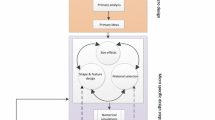Abstract
The number of products benefiting from micro components in the market is increasing, and consequently, the demand for well-matched tools, equipment and systems with micro features is eventually increasing as well. During the design process of micro products, a number of issues appear which are inherent due to the down scaling or physical phenomena dominating in the micro range but negligible in the macro scale. In fact, some aspects in design for micro manufacturing are considerably different compared to the design procedure taken at the macro level. Identifying the differences between design considerations at micro compared to macro scale, and defining potential guidelines based on them, provides an opportunity to modify the conventional design methodologies towards becoming micro specific. In this paper, the need for a micro-oriented approach for designing micro products which has not been investigated hitherto studied. For this purpose, an additional step named “Rules To Consider” (RTC) is added to the conventional design methodologies. This step is constituted based on the feedbacks gained during analyzing the different iterations of the design. The knowledge obtained during the design process of a micro product can be added to the RTC unit, and this unit becomes enriched progressively in design process of similar micro products and supplemented to the conventional design methodologies to be served as a micro-oriented design methodology. In order to present the application of RTC unit, the design process of a micro heat exchanger is investigated. Manufacturability and functional performance are considered as evaluation criteria, and the lessons learned from each design iteration and evaluation are employed in the subsequent design proposals until an acceptable design is achieved. Thermal performance of the heat exchangers is evaluated using finite element (FE) simulation of the conjugate heat transfer. The design proposals are optimized in terms of geometrical dimensions, and a sensitivity analysis is conducted on the mass flow rate and heat generation power in the heat source. Finally, the designs with higher thermal performance and manufacturability are introduced. The result of the thermal analysis reveals the fact that the presence of the fins and modification of their dimensions as well as the constituent material for fabricating the micro heat exchanger do not significantly improve the thermal performance of the micro heat exchangers. This is an interesting outcome which can result in considerable reduction of the manufacturing costs by simplifying the geometrical design of the heat exchanger. The micro-specific design considerations which are extracted from the design process of the micro heat exchanger are added to the RTC unit and can be applied as guidelines in design process of any other micro heat exchanger. In other words, the current study can provide a useful guideline in design for manufacturing of micro products.
Similar content being viewed by others
References
Alting L, Kimura F, Hansen HN, Bissacco G (2003) Micro engineering. CIRP Ann Manuf Technol 52:635–657. doi:10.1016/S0007-8506(07)60208-X
Baehr HD, Stephan K (2011) Heat and mass transfer. doi:10.1007/978-3-642-20021-2
Chan WL, Fu MW, Yang B (2011) Study of size effect in micro-extrusion process of pure copper. Mater Des 32:3772–3782. doi:10.1016/j.matdes.2011.03.045
Cross N (2008) Engineering design methods: strategies for product design. J. Wiley, Chichester
German RM, Johnson JL (2003) PIM materials. Adv Mater Process 161:35–39
Harris C, Despa M, Kelly K (2000) Design and fabrication of a cross flow micro heat exchanger. J Microelectromech Syst 9:502–508. doi:10.1109/84.896772
Johnson JL, German RM (2005) Design capabilities of powder injection molded materials. J Adv Mater 37:51–59
Maekawa H, Komoriya K (2001) Development of a micro transfer arm for a microfactory. Proc 2001 ICRA IEEE Int Conf Robot Autom (Cat No01CH37164) 2:1444–1451. doi:10.1109/ROBOT.2001.932813
Masuzawa T (2000) State of the art of micromachining. CIRP Ann Manuf Technol 49:473–488. doi:10.1016/S0007-8506(07)63451-9
Mishima N (2003) Design of a miniature manufacturing system for micro-fabrication. Proc 10th ISPE Int. Conf. Concurr. Eng. Res. Appl. Madrid, Spain, pp 1129–1135
Mounier E (2002) MEMS, the alternative semiconductor business. Proc. 3rd Euspen Int. Conf. Eindhoven, Netherlands, pp 391–394
Omidvarnia F, Hansen HN, Bissacco G, Islam A (2014) Integrated design, an approach towards DfμMA. 13th Int. Des. Conf. - Des. 2014. Dubrovnik, Croatia, pp 343–352
Ooyama N, Kokaji S, Tanaka M, et al (2000) Desktop machining microfactory. Proc 2nd Int. Int. Work. microfactories. Neuchatel, Switzerland, pp 13–16
Pahl G, Beitz W, Feldhusen J, Grote K. (2006) Engineering design: a systematic approach. 3rd edn. Springer
Panton RL (2013) Incompressible flow. doi:10.1002/9781118713075
Qin Y (2006) Micro-forming and miniature manufacturing systems — development needs and perspectives. J Mater Process Technol. doi:10.1016/j.jmatprotec.2006.03.212
Schmekel H, Sohlenius G (1989) Functional models and design solutions. CIRP Ann Manuf Technol 38:129–132. doi:10.1016/S0007-8506(07)62667-5
Tjalve E (1976) Systematic design of industrial products. Copenhagen, Denmark
Yuichi O, Kitahara T (2000) Micro-lathe equiped with closed-loop numerical control. Proc 2nd Int. Work. microfactories. Neuchatel, Switzerland, pp 87–90
Author information
Authors and Affiliations
Corresponding author
Rights and permissions
About this article
Cite this article
Omidvarnia, F., Hansen, H.N. & Sarhadi, A. A systematic approach applied in design of a micro heat exchanger. Int J Adv Manuf Technol 82, 1187–1195 (2016). https://doi.org/10.1007/s00170-015-7401-y
Received:
Accepted:
Published:
Issue Date:
DOI: https://doi.org/10.1007/s00170-015-7401-y




